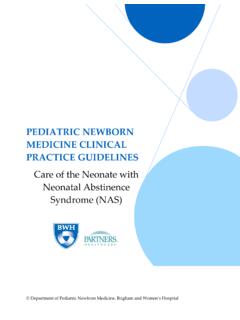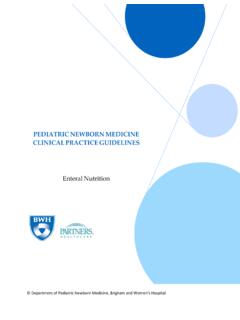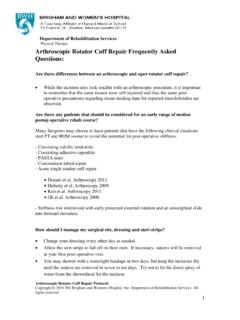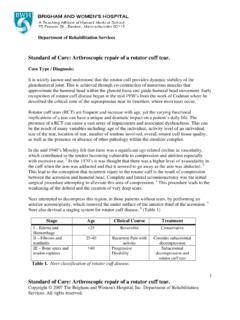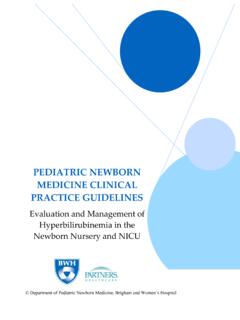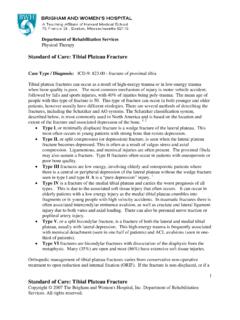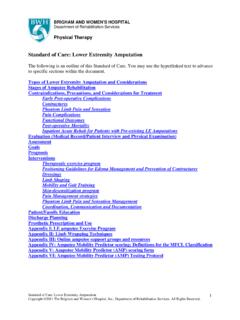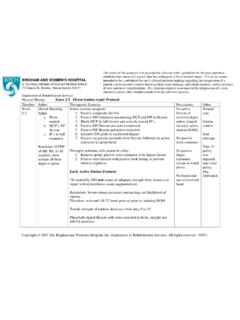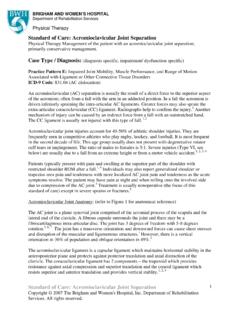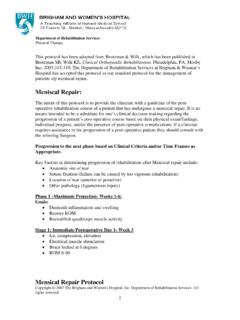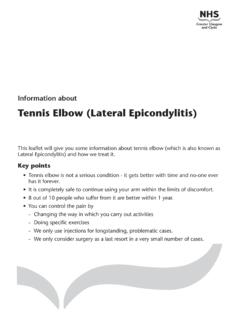Transcription of Post-Op Protocol for Lateral Epicondyle Debridement
1 Department of Rehabilitation Services: Physical Therapy Post-Op Protocol for Lateral Epicondyle Debridement The intent of this Protocol is to provide the clinician with a guideline of the post- operative rehabilitation course of a patient that has undergone Lateral Epicondyle Debridement . It is by no means intended to be a substitute for one's clinical decision making regarding the progression of a patient's post-operative course based on their physical exam/findings, individual progress, and/or the presence of post-operative complications. If a clinician requires assistance in the progression of a post-operative patient they should consult with the referring Surgeon. Phase 1: Days 1-7. Position the extremity in a sling for comfort. Control edema and inflammation: Apply ice for 20 minutes two to three times a day. Gentle hand, wrist, and elbow range of motion (ROM) exercises. Exercises should be done in a pain-free ROM. Active shoulder ROM. Periscapular exercices Patient should minimize the frequency of any activities of daily living (ADLs).
2 That stress the extensor tendon mechanism such as lifting, and combined joint movements ( full elbow extension with wrist flexion). When lifting and/or performing activities with the surgical upper extremity it is advise to have the patient perform such tasks with their palm up to minimize work load f extensor tendons. Consider pre-fab / custom wrist splint to minimize wrist extension activity if patient is acutely painful with such activities. Elbow pad for protection of incision site. Education on work / activity modification. Post-Op Protocol for Lateral Epicondyle Debridement 2010, Department of Rehabilitation Services, Brigham & Women's Hospital, Boston, MA. 1. Department of Rehabilitation Services: Physical Therapy Phase 2: Weeks 2-4. Discontinue sling. Begin passive range of motion (PROM). Passive motion should be continued and combined with active-assisted motion within end-range of patient's pain tolerance Gentle strengthening exercises with active motion and sub maximal isometrics.
3 Edema and inflammation control: Continue to ice application 20 minutes two to three times a day. Tubigrip as needed. Scar management as needed. Continue work / activity modification education. Phase 3: Weeks 5-7. Advanced strengthening as tolerated to include weights or theraband. Focus should be on endurance training of wrist extensors ( light weights, higher repetitions per set). ROM with continued emphasis on restoring full A/PROM. Edema and inflammation control with ice application for 20 minutes after activity. Modified activities in preparation for beginning functional training. Gentle massage along and against fiber orientation. Counterforce bracing to common extensor tendon of forearm. (Including education on proper use to avoid nerve compression.). Phase 4: Weeks 8-12. Continue counterforce bracing if needed for patient to completed ADLs and/or strengthening activity pain-free. Begin task-specific functional training. Return to higher-level work / recreational activities.
4 Reference: Brotzman SB, Wilk KE, Clinical Orthopeadic Rehabilitation. Philadelphia, PA: Mosby Inc; 2003. Formatted: Ethan Hope Reviewers: Post-Op Protocol for Lateral Epicondyle Debridement 2010, Department of Rehabilitation Services, Brigham & Women's Hospital, Boston, MA. 2. Department of Rehabilitation Services: Physical Therapy 8/06 Reg B. Wilcox III, PT. Nancy Kelly, OT. Reviewed: Reg B. Wilcox III, PT Gayle Lang, OT. 3/10. Post-Op Protocol for Lateral Epicondyle Debridement 2010, Department of Rehabilitation Services, Brigham & Women's Hospital, Boston, MA. 3.
